Understanding Cockroach Bites: Health Implications & Management
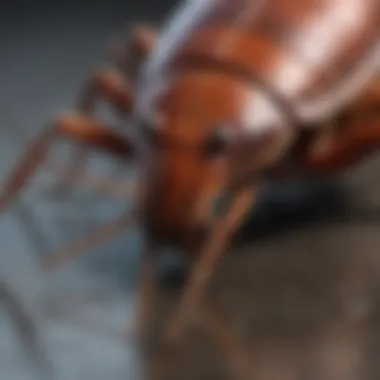
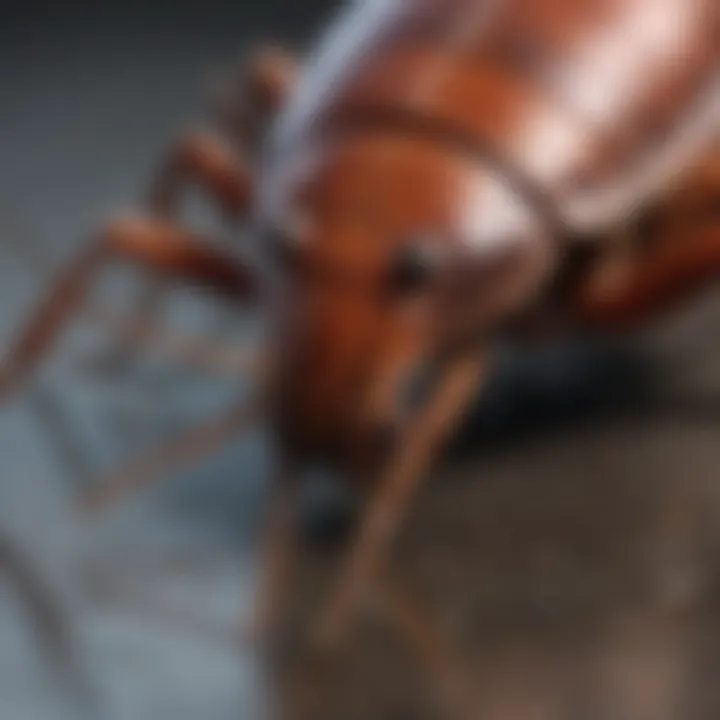
Intro
Cockroach bites are often overshadowed by the more prevalent discussions surrounding common pests and their management. However, understanding these bites is essential for those who encounter these insects in their homes or gardens. This section aims to provide a clear introduction to key aspects regarding cockroach bites, shedding light on their implications, symptoms, and management strategies.
By examining these factors, readers will gain insight into not just the nature of cockroaches as pests, but also the health considerations that arise when these creatures come into contact with humans.
Understanding Pests
Definition of Pests
Pests are typically defined as organisms that cause harm or annoyance to humans, plants, or animals. Cockroaches are included in this category due to their potential to spread disease and contaminate food sources. Their presence often signals a broader problem within the home environment, calling for immediate attention and action.
Importance of Pest Identification
Identifying the specific type of pest can help in determining appropriate control measures. Cockroaches, particularly the American cockroach and the German cockroach, can lead to various health issues. For effective management, understanding their behavior and ecology is crucial.
Prevention Techniques
Home and Garden Preventative Measures
To minimize the risk of cockroach bites, homeowners can take several steps:
- Maintain cleanliness: Regularly clean surfaces, especially food preparation areas.
- Seal entry points: Use caulk to close gaps around windows, doors, and foundations.
- Store food securely: Keep food in airtight containers.
These measures not only help prevent infestations but also decrease the likelihood of bites.
Seasonal Prevention Tips
Changes in seasons can influence pest behavior. Here are some tips:
- Spring: Inspect your home for cracks and entry points as cockroaches look for nesting sites.
- Summer: Ensure excellent outdoor waste disposal to prevent attracting these pests.
- Fall: Prepare for colder months by sealing off all potential entryways.
Eco-Friendly Pest Control Solutions
Overview of Sustainable Practices
Many homeowners are increasingly interested in sustainable pest control methods. This approach emphasizes the use of environmentally friendly techniques that effectively manage pest populations without harming other aspects of the ecosystem. These methods can include:
- Biological control: Introducing natural predators to reduce pest populations.
- Integrated pest management (IPM): Employing a combination of techniques to manage pests holistically.
Natural Remedies and Their Effectiveness
Natural remedies for cockroach management often prove effective. Some popular options include:
- Boric acid: A substance that disrupts the cockroach's digestive system and can reduce populations when applied in targeted areas.
- Diatomaceous earth: Another natural option that dehydrates cockroaches upon contact.
Each of these methods allows for a sustainable approach without the need for harsh chemicals.
"Understanding the biological mechanisms behind pests can greatly enhance our ability to manage them effectively."
By exploring the above topics, homeowners can feel empowered to tackle the implications of cockroach bites, fully equipped with the knowledge of symptoms and management strategies. Doing so aids in creating a safer and healthier living environment.
Foreword to Cockroach Bites
In the realm of pest management, cockroach bites often fall under the radar. They are not as commonly discussed as other pest-related issues, yet understanding them is vital. Cockroaches can pose health risks through their interactions with humans, especially when bites occur. This makes an exploration of cockroach bites essential, not only for awareness but also for effective prevention and management.
Defining Cockroach Interactions
Cockroach interactions refer to the various ways these pests come into contact with humans and their environments. While many view cockroaches merely as unwelcomed guests in homes, their behavior and biology reveal more complexity. Cockroaches are omnivorous insects with a natural curiosity. They often search for food, water, and shelter in human residences, leading to potential encounters that can result in bites.
Importantly, the likelihood of a bite increases under specific conditions. For instance, when a cockroach feels threatened or cornered, it may resort to biting as a defensive mechanism. Understanding these interactions provides insight into when and why bites may occur. Furthermore, recognizing their habitat preferences helps households to reduce the likelihood of infestations, thereby lowering the risk of bites.
Overall, discussing cockroach bites offers not just a glimpse into the potential risks but also informs individuals about preventive measures and response strategies. By understanding how cockroaches operate and interact with people, homeowners can take informed steps to safeguard their living spaces from these unwanted pests.
Biology of Cockroaches
The biology of cockroaches plays a significant role in understanding their interactions with humans and potential bites. By exploring their anatomy, feeding habits, and behavioral patterns, we can better appreciate how these creatures function in their environment. Furthermore, understanding cockroach biology offers insights into why they may bite, which is crucial for effective pest management and avoidance strategies.
Cockroach Anatomy and Feeding Habits
Cockroaches possess a complex anatomy that helps them survive in various environments. Their exoskeleton, made of chitin, provides protection while allowing flexibility. Notably, many species can close their spiracles, which are openings for respiration, enabling them to survive in low-oxygen environments for extended periods.
Feeding habits vary among species, but many thrive on decaying organic material. Their mouthparts are designed for chewing, allowing them to consume a wide range of foods. This includes food scraps, paper, and even fabric when nutrients are present. An important aspect of cockroach feeding is their ability to transmit pathogens through their saliva and feces. Bites may occur when these insects mistake skin for food or are provoked, thus emphasizing the need for effective management practices.
Behavioral Patterns
Cockroaches exhibit specific behavioral patterns that impact their interaction with humans. They are primarily nocturnal, preferring to forage for food at night. This nocturnal behavior reduces encounters with people, although it can lead to surprising bites if startled. Cockroaches are social insects, often found in groups, which can increase the likelihood of bites during invasive encounters.
In addition to their feeding habits, cockroaches have an incredible ability to sense their environment. They rely on their antennae to detect pheromones and food sources. This adaptation contributes to their success as pests in homes and businesses.
"Understanding not only the biology of cockroaches but also their behavior allows for more effective pest control strategies."
Awareness of their biology aids in developing targeted methods for reducing their populations. Utilizing this knowledge effectively can enhance human safety and comfort. Cockroach biology is not a mere academic interest but a practical concern for those looking to protect their homes.
Can Cockroaches Bite Humans?

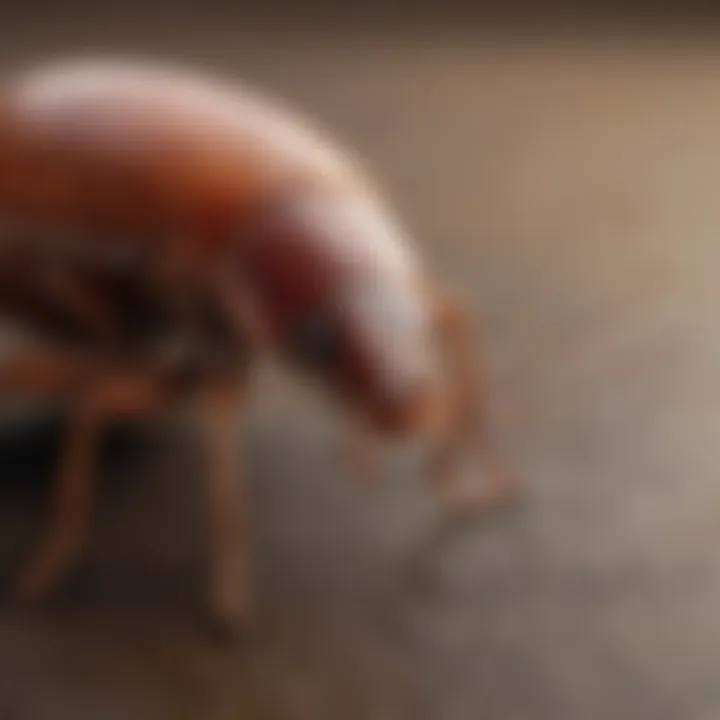
The question of whether cockroaches can bite humans is often overlooked, yet it is crucial for housewives and homeowners to understand. Although these insects are generally considered more nuisance than danger, their ability to bite can have considerable implications for health and hygiene. Knowing about cockroach bites helps individuals take necessary precautions, ensures timely medical intervention if needed, and informs better pest management strategies.
Frequency of Bites
Cockroach bites are not a common occurrence, but they can happen. According to some studies, the incidence is relatively low compared to other household pests like mosquitoes or bedbugs. Bites usually occur in conditions where humans and cockroaches cohabitate closely, especially during the night when people are sleeping.
Some relevant statistics indicate:
- Most bites are reported in urban environments, where cockroaches thrive.
- Bites are more frequent in areas with poor sanitation, providing a hospitable environment for these creatures.
- They are often more prevalent when food is left unattended or in open containers.
Conditions Leading to Bites
Understanding the conditions that could lead to cockroach bites is essential. These insects typically prefer dark, warm places and often come out at night, seeking food and moisture. The following conditions can increase the likelihood of bites:
- Improper food storage: Leaving food exposed can attract cockroaches, increasing the chance of contact.
- Poor hygiene: Accumulation of waste, crumbs, and spills can create a breeding ground for cockroaches.
- Night-time activities: Humans stirring in their sleep can inadvertently attract biting cockroaches that do not feel threatened.
- Compromised living spaces: Cracks, crevices, and holes can serve as entry points, allowing cockroaches to invade homes more frequently.
It is essential to note that the primary interest of cockroaches is food, not humans. Biting occurs when they are in search of sustenance or feel threatened.
Symptoms of Cockroach Bites
Understanding the symptoms of cockroach bites is crucial for promoting awareness and effective management strategies. Although these bites are not as widely recognized as those from other pests, they can lead to noticeable reactions that warrant attention. Recognizing the signs can assist in identifying the bite's source, and further prevent complications. This section explores the immediate reactions to bites, as well as any potential long-term effects that may follow, emphasizing the importance of this knowledge for both homeowners and housewives alike.
Immediate Reactions
When a cockroach bites, the initial reaction can vary from mild discomfort to more pronounced symptoms. Common immediate reactions include:
- Redness and Swelling: Similar to other insect bites, a cockroach bite can result in localized swelling and redness. This is due to the body's natural inflammatory response to the foreign body or irritant.
- Itching and Burning Sensation: Many individuals report feeling an itch or a burning sensation at the bite site. This discomfort can lead to scratching, which may exacerbate the reaction or introduce bacteria.
- Pain: In some cases, the bite might be painful, comparable to a mosquito bite. Pain levels can depend on the individual's sensitivity and the specific area of the body affected.
- Allergic Reactions: Some individuals may experience an allergic reaction, which can manifest as hives, severe itching, or even difficulty breathing. This is rarer but requires immediate medical attention.
"Recognizing the immediate reactions to a cockroach bite is key to preventing further complications."
Long-Term Effects
While immediate reactions typically resolve within a few days, potential long-term effects should not be overlooked. They may include:
- Secondary Infections: Continuous scratching can break the skin, leading to bacterial infections. Signs of infection include increased redness, pus, and persistent pain.
- Scarring: In severe cases, if the bite site becomes infected or if an individual has a tendency to scar, the affected area may heal with a permanent mark.
- Post-Traumatic Stress: For some, the experience of a cockroach encounter can be psychologically distressing, leading to anxiety, especially in those with a strong fear of pests.
- Ongoing Allergic Reactions: Individuals with pre-existing allergies may find that subsequent contacts with cockroaches exacerbate their symptoms, making them more susceptible to reactions with each encounter.
Having a clear comprehension of both immediate and long-term symptoms plays a vital role in managing the risks associated with cockroach bites. It empowers individuals to take appropriate actions, such as consulting medical professionals or making lifestyle adjustments to prevent future occurrences.
Health Implications of Cockroach Bites
Understanding the health implications of cockroach bites is crucial for house owners and those responsible for maintaining a healthy living environment. Awareness of potential risks can significantly improve precautionary measures and responses to bites. Cockroaches, while often seen as mere nuisances, can lead to various health issues when they interact with humans. This section will delve into the risks of infections and allergic reactions stemming from these bites.
Infection Risks
Infection is a notable concern when it comes to cockroach bites. While cockroaches themselves are not direct vectors of major diseases, they are carriers of numerous pathogens due to their scavenging habits. These pests often inhabit dirty environments, including sewers and garbage, collecting bacteria and viruses on their bodies. When a cockroach bites, it can introduce these pathogens into the wound. This risk is particularly elevated if the bite is scratched or becomes contaminated with dirt.
Key points on infection risks include:
- Bacterial Infections: Staphylococcus and Escherichia coli are two common bacteria that can lead to skin infections post-bite.
- Antibiotic Treatment: If an infection develops, prompt medical attention is needed. Antibiotics could be necessary to treat bacterial infections.
- Surface Wounds: Even minor wounds that arise from bites can become infected if not properly cared for, highlighting the importance of wound hygiene.
"Proper wound care is essential to prevent infections after a cockroach bite."
Allergic Reactions
Allergic reactions to cockroach bites are another significant health implication. Some individuals may experience localized reactions, which could include swelling, redness, and itching. In more severe cases, systemic allergic responses, known as anaphylaxis, can occur but are quite rare.
Common allergens associated with cockroaches include proteins found in their feces, saliva, and body parts. Thus, the presence of cockroaches in a home can indirectly exacerbate allergic conditions, particularly in individuals already sensitized to cockroach allergens.
Allergic reactions may result in:
- Localized Symptoms: These include irritating reactions at the bite site, such as hives or dermatitis.
- Severe Responses: Shortness of breath or general swelling may suggest a more serious reaction, necessitating immediate medical intervention.
- Chronic Issues: Continued exposure to cockroach allergens may lead to asthma attacks or long-term respiratory problems, making it crucial for individuals with pre-existing conditions to manage their environment carefully.
Diagnosis and Treatment
Understanding how to diagnosis and the subsequent treatment of cockroach bites is essential for mitigating health risks and increasing awareness. These bites, while uncommon, can lead to various medical complications. Recognizing the symptoms and the appropriate responses can greatly influence recovery. It is important for individuals, particularly housewives and homeowners, to grasp the significance of this knowledge for themselves and their families.
Medical Evaluation
When someone suspects a cockroach bite, a medical evaluation becomes a necessary step. This evaluation should ideally occur soon after the incident. Health professionals will typically conduct a thorough examination of the bitten area. They will assess for patterns typical of cockroach bites, which might exhibit swelling or redness. In certain cases, they might advise relevant blood tests to discern any allergic reactions or infections that could occur.
This evaluation helps ensure that appropriate steps are taken to treat any possible underlying infections. Additionally, it provides an opportunity for preventive education on pest management.
Home Remedies vs. Medical Treatments
In the realm of treating cockroach bites, there are both home remedies and medical treatments that individuals can consider. Understanding the differences can help guide an appropriate response depending on severity of the symptoms.
Home Remedies:
- The use of cold compresses can help reduce swelling and soothe discomfort.
- Over-the-counter antihistamines like diphenhydramine may alleviate itching.
- Natural remedies, such as aloe vera, are also popular due to their soothing properties on skin irritations.
Medical Treatments:
- If symptoms worsen or if there are signs of infection, prescription medications may become necessary. Antibiotics can be needed for infections, especially if symptoms do not improve.
- Corticosteroid creams might be prescribed for severe allergic reactions.
It is crucial to weigh the benefits of immediate home care against the need for professional medical intervention. While home treatments may be useful for minor symptoms, persistent or worsening conditions should always be subject to medical advice.
Takeaway: Always prioritize medical evaluation in cases of severe symptoms or significant discomfort. Knowing when to escalate care is part of umdas effective post-bite strategy.
Preventing Cockroach Bites
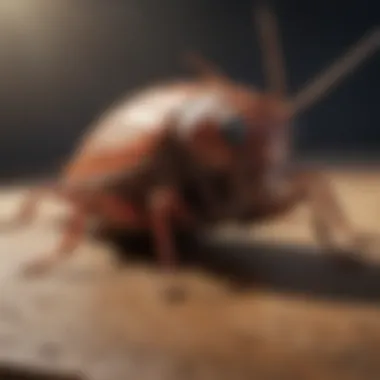
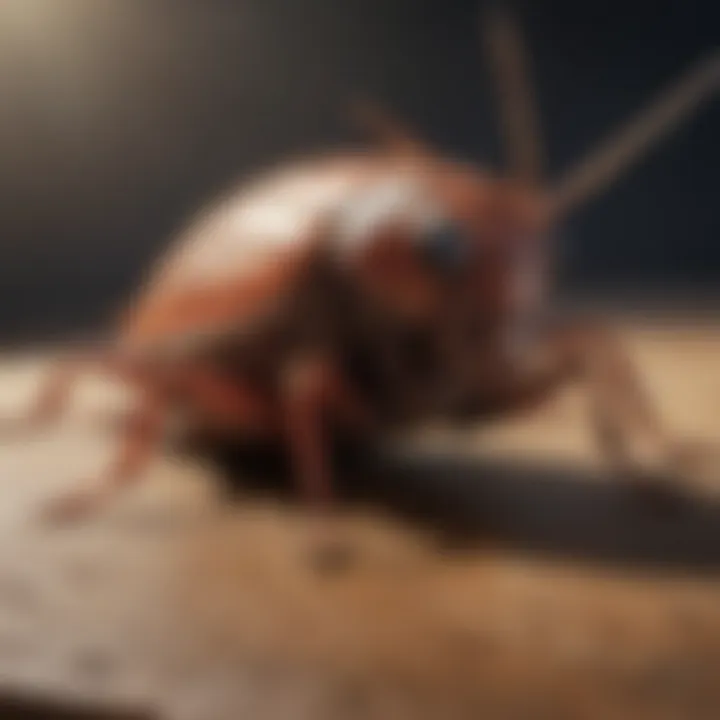
Preventing cockroach bites is crucial for maintaining a safe and healthy living environment. Cockroaches are often seen as merely a nuisance, but their ability to bite can pose significant health risks. Understanding how to keep these pests at bay not only helps in preventing physical encounters but also reduces the chances of spreading diseases they might carry. It is essential to recognize the factors that make a home attractive to cockroaches and address those effectively.
Home Environment Modifications
Making modifications to your home environment is one of the first steps to preventing cockroach infestations. Here are some effective modifications:
- Seal Cracks and Crevices: Cockroaches can enter through small openings. Inspect your home for cracks around windows, doors, and foundations. Sealing these gaps helps block entry points.
- Maintain Cleanliness: A clean home discourages cockroaches. Regularly clean countertops, floors, and any surfaces where food might collect. Also, ensure that food is stored in airtight containers.
- Manage Waste Effectively: Dispose of garbage regularly. Use trash bins with tightly fitted lids to avoid attracting cockroaches.
- Fix Leaks: Addressing leaks throughout your home will help reduce moisture. Cockroaches thrive in damp environments, so eliminating excess water is beneficial.
- Reduce Clutter: Limit clutter, especially in areas like basements and attics. Cockroaches enjoy hiding in dark and cluttered spaces, hence keeping these areas organized can deter their presence.
By implementing these home modifications, you can create an environment less conducive to cockroach habitation.
Best Practices in Pest Control
To effectively prevent cockroach bites, adopting best practices in pest control is essential. Here are some noteworthy recommendations:
- Regular Inspections: Conduct inspections in your home routinely. Look for signs of cockroach activity, like droppings or shed skins. Early detection can prevent greater infestations later.
- Integrated Pest Management (IPM): Employ IPM strategies that combine multiple pest control methods. This may include sanitation, structural repairs, and use of pesticides as a last resort.
- Professional Pest Control Services: If infestations are severe, seeking help from professional pest control services might be necessary. They have expertise and tools to eradicate pests effectively.
- Use of Baits and Traps: Placing cockroach baits and traps in strategic locations can help monitor and control populations. Ensure they are out of reach of children and pets.
- Proper Use of Insecticides: If chemical treatments are necessary, read and follow the label instructions carefully. Choose insecticides specifically designed for home use, ensuring safety for residents.
Implementing these pest control practices will not only reduce the likelihood of cockroach bites but will also contribute to a healthier living space.
Remember: Consistent and preventive actions are key to minimizing encounters with cockroaches and ensuring a safer home environment.
Reducing Cockroach Populations
Reducing cockroach populations is pivotal not only for public health but also for enhancing the comfort of living spaces. These pests can pose significant risks, including the transmission of diseases and causing allergies. Their presence can disrupt the home environment, making it crucial to adopt effective measures for their population control.
A thorough understanding of cockroach behavior and biology can grant insights into effective management strategies. Implementing both chemical solutions and eco-friendly approaches can yield significant results in reducing these unwanted intruders.
Chemical Solutions
Chemical solutions often include the use of pesticides specifically designed to target cockroach species. Popular options encompass products such as Raid Ant and Roach Killer, Ortho Home Defense, and Hot Shot Bed Bug and Flea Killer. These pesticides contain active ingredients that effectively disrupt the cockroach's nervous system, leading to their downfall.
Advantages of Using Chemical Solutions:
- Immediate Results: Pesticides can quickly reduce cockroach numbers.
- Wide Reach: Many products can cover large areas, making them efficient for extensive infestations.
- Targeted Application: Some products are designed for indoor use and can be localized to areas with significant cockroach activity.
Considerations:
- Safety Concerns: Ensure that products are safe for use in homes, especially around children and pets.
- Resistance Issues: Over-reliance on chemical solutions can lead to resistance in cockroach populations, making future management more challenging.
- Follow-Up Treatment: Regular monitoring and treatment may be necessary to maintain an effective control strategy.
Eco-Friendly Approaches
Many households now favor eco-friendly approaches to managing cockroach populations. These methods aim to minimize chemical use while effectively mitigating infestations. Options include natural repellents and preventive measures.
Effective Eco-Friendly Solutions:
- Diatomaceous Earth: This natural powder can be scattered in areas where cockroaches frequent. It dehydrates them, resulting in death without the use of harmful chemicals.
- Boric Acid: When used properly, boric acid is a low-toxicity option that disrupts the cockroach's digestive system. It can be placed in baits or dusted in hidden areas.
- Essential Oils: Oils such as peppermint and tea tree can repel cockroaches when diluted in water and sprayed around potential entry points.
Benefits of Eco-Friendly Approaches:
- Less Environmental Impact: These solutions often avoid synthetic chemicals, promoting a healthier home environment.
- Safer for Children and Pets: Many eco-friendly methods pose fewer risks to family members and pets than traditional pesticides.
- Permanent Solutions: Using preventive measures can lead to long-term reductions in cockroach populations.
As you explore these various methods for reducing cockroach populations, it is important to remember the long-term commitment required. Effective management relies on combining strategies and maintaining vigilance in monitoring cockroach activity. With appropriate actions, homeowners can successfully reclaim their living spaces from these pests.
Coping Strategies After a Bite
The experience of a cockroach bite can be unsettling. While these incidents may not be common, knowing how to respond effectively is crucial. Having a strategy for coping can mitigate effects and improve recovery. These strategies encompass immediate first aid measures and understanding when it’s necessary to seek medical attention.
First Aid Measures
Taking prompt action after a cockroach bite can ease symptoms and prevent complications. First, clean the bite area carefully.
- Wash with soap and water: This helps remove any saliva or potential contaminants from the bite.
- Apply a cool compress: This can reduce swelling and provide relief. Keep it on the bite for about 10 to 15 minutes.
- Use antiseptics: Applying a topical antibiotic ointment can prevent infection. Choose products like Neosporin or similar alternatives.
- Manage pain: Over-the-counter pain relief such as ibuprofen or acetaminophen can be effective if pain persists.
It’s also advisable to monitor the bite site over the next few days. Look for signs of infection such as increased redness, warmth, or pus. If any of these develop, further action may be warranted.
When to Seek Medical Help
Though most cockroach bites are minor, there are circumstances when professional medical help is essential. Individuals should consider seeing a healthcare provider if:
- The bite area shows signs of severe infection.
- Symptoms such as excessive pain, swelling, or fever develop.
- Any allergic reactions occur, including difficulty breathing, swelling of the face, or hives.
- The bite appears to worsen over time instead of improving.
It’s prudent to err on the side of caution. Seeking care can ensure health and early management of potential complications.
Knowing effective coping strategies after a cockroach bite not only aids recovery but also furnishes peace of mind. Whether the response is immediate self-care or reaching out for professional advice, understanding the right steps fosters a better outcome.
The Ecological Role of Cockroaches
Cockroaches are often seen as pests in human environments, yet they play a vital role in ecosystems. Understanding their ecological significance can provide insights into why these insects exist and how they can impact both the environment and human health.
Cockroaches in Ecosystems
Cockroaches contribute significantly to nutrient cycling within ecosystems. They are detritivores, which means they feed on decomposing organic matter. By consuming dead plant and animal material, they help break it down into smaller particles, making nutrients available for plants. This process is essential for soil health and supports plant growth, promoting biodiversity. Therefore, removing cockroaches from an ecological context can disrupt this vital process, harming not only soil quality but also the overall health of the ecosystem.
In addition, cockroaches serve as a food source for various predators such as birds, reptiles, and other insects. This positions them in the food web and illustrates their importance in maintaining ecological balance. Their presence indicates a healthy environment, as they thrive on decaying matter that might otherwise accumulate and create unsanitary conditions.
Impact on Human Habitats


While cockroaches have a necessary ecological role, their interaction with human habitats creates complex issues. Their adaptability allows them to thrive in urban settings, often leading to unwanted infestations. This can contribute to contamination and health concerns. For instance, cockroach droppings, saliva, and body parts can act as allergens. In sensitive individuals, this may lead to allergic reactions or exacerbate asthma conditions.
Moreover, their role as scavengers can inadvertently lead to health risks. If they have been in contact with decaying food or waste, they can transfer pathogens to food preparation areas, which is why maintaining cleanliness in homes is crucial.
"Understanding the role of cockroaches in ecosystems can help mitigate the negative perceptions and address the health implications effectively."
It is also worth noting that the ecological role of cockroaches can be seen as a double-edged sword. While they help with decomposition and nutrient recycling, their presence in human spaces raises questions about pest management and health safety.
Controversies Surrounding Cockroach Bites
When it comes to discussing household pests, cockroaches occupy a unique position. They inspire fear and disgust in many, yet there are significant misunderstandings regarding their interactions with humans, especially regarding the potential for bites. This section aims to clarify these controversies, shedding light on cultural perceptions, ecological roles, and scientific facts surrounding cockroach bites.
Cultural Perceptions and Misunderstandings
Cultural attitudes towards cockroaches often skew negative. Many people view these insects as purely harmful, associating their presence with uncleanliness and disease. However, this perception overlooks important aspects. For instance, cockroaches can bite humans, but this occurrence is relatively rare and usually happens in specific conditions. Understanding this can reduce unwarranted fears and promote a more balanced view of these creatures.
Here are some common misunderstandings:
- All Cockroaches Bite: Not all species pose a biting threat. Many common types, like the American cockroach, tend to avoid humans.
- Biting is Aggressive: Cockroaches do not bite due to aggression. Rather, if they bite, it is often an act of defense or if they are provoked.
- Cockroaches are Dirty: While these insects can carry pathogens, their presence does not automatically indicate filth. They often enter homes searching for food, water, and shelter.
This tendency to conflate cockroaches with disease has significant implications. It affects homeowners’ perceptions and ultimately impacts pest management strategies. Instead of focusing entirely on extermination, understanding the environmental factors that encourage infestations can be more beneficial. Moreover, promoting clean environments can deter these pests more effectively than poison alone.
"Understanding the biology and behavior of cockroaches can shift the conversation from fear to informed management."
In addition, education plays a crucial role. Many homemakers might seek to eradicate cockroaches without fully understanding the implications of certain pest control methods. For example, the indiscriminate use of chemicals can lead to potential health concerns for families and pets. A more nuanced approach that considers both the human and ecological perspectives can foster better pest management practices.
In summary, acknowledging cultural perceptions about cockroaches is vital to rethink their role in human habitats. It’s essential to provide accurate information that frames these insects in a context of understanding rather than fear. This perspective will lead to more informed discussion and practical management strategies.
Research on Cockroach Bites
Research on cockroach bites is crucial for multiple reasons. First, it helps demystify the common misconceptions surrounding these pests, particularly regarding their interactions with humans. Certian studies have begun to unravel the biological mechanisms behind cockroach bites, shedding light on how these pests can harm or affect human health. Understanding these dynamics provides valuable insight into pest management practices, emphasizing the importance of proactive measures.
Moreover, thorough research facilitates a better comprehension of the symptoms associated with cockroach bites. This knowledge is essential for individuals, such as housewives and homeowners, who may find themselves in environments potentially conducive to cockroach infestations.
Identifying signs of bites can lead to quicker medical responses and effective management strategies, thus limiting health implications.
Current Studies and Findings
Current studies investigate the frequency and circumstances under which cockroaches bite humans. Many of these studies highlight that bites are relatively uncommon but can occur during instances of close contact, such as when humans are asleep. Researchers note that cockroaches may bite when provoked, particularly if they are startled or feel threatened. Additionally, some studies explore the relationship between cockroach populations and the health risks they pose, focusing on the allergens they produce.
Another pertinent aspect of research is the analysis of cockroach saliva and its potential reactions in humans. Recent findings indicate that the protein composition in cockroach saliva can trigger allergic responses in some individuals. This information can aid in understanding the long-term health implications of cockroach bites while promoting awareness about allergic reactions in sensitive populations.
Future Research Directions
Future research should focus on several key areas to enhance the understanding of cockroach bites. First, a deeper exploration into the biological and immunological responses to cockroach bite incidents will be valuable. This could help clarify symptoms and develop more effective treatments for those affected.
Furthermore, studies should also aim to evaluate the effectiveness of current pest control methods in minimizing cockroach populations and, by extension, the potential for bites. This includes assessing both chemical and eco-friendly approaches, providing a balanced stance on pest management practices.
Engaging with community health awareness programs is another important direction. Encouraging participatory research that involves homeowners can yield insights into real-world challenges and experiences with cockroach infestations. Such collaborative efforts can help develop practical and community-oriented pest management solutions.
The Importance of Awareness
Awareness of cockroach bites is vital for various reasons. First, understanding the potential health risks can help individuals make informed decisions about prevention and treatment. While these insects are often dismissed as mere nuisances, their bites can lead to infections and allergic reactions. Educating oneself about the symptoms and management strategies can mean the difference between a minor issue and a significant health concern.
Additionally, awareness fosters an understanding of preventive measures that can be implemented in domestic environments. Recognizing the signs of cockroach activity within the household allows homeowners to take immediate action. This not only protects their family but also enhances overall cleanliness and hygiene within their living spaces.
Furthermore, by being informed, individuals can contribute to a broader discussion on pest management practices. Many people remain unaware of the ecological roles cockroaches play, which can lead to misguided pest control strategies. Therefore, educating the public about effective and responsible pest management becomes essential to minimize unnecessary harm.
"Understanding the implications of cockroach bites enables better health outcomes and a cleaner living environment."
Through awareness, individuals can develop a proactive stance toward pest management. This fosters an atmosphere where pest problems are addressed before they escalate. By sharing knowledge with friends and community members, awareness stands as a cornerstone for effective management strategies against cockroaches.
Educating the Public
Educating the public about cockroach bites encompasses several key components. Most importantly, it involves communicating the risk factors associated with these encounters. Many individuals might not realize that cockroaches can bite, leading to an underestimation of their potential threats. Awareness campaigns can include informational workshops or distribution of written materials that explain the various health implications that might arise from these bites.
In addition to traditional education formats, the use of social media platforms like Facebook can help spread messages more widely. People can share personal experiences to highlight the urgency and provide practical advice for those who may face similar situations. Engaging content on platforms like Reddit can also elicit dialogues, allowing people to learn from one another and establish community solutions for pest management.
Promoting Better Pest Management Practices
Promoting better pest management practices is essential in reducing the instances of cockroach bites. Homeowners often resort to quick fixes without understanding the broader implications of their pest control choices. Educating them on the importance of integrated pest management, which combines biological, physical, and chemical controls, is beneficial.
Effective practices include:
- Regular inspections of living spaces
- Sealing entry points where cockroaches can infiltrate
- Maintaining cleanliness to reduce attractants
By emphasizing the concept of prevention over reactive measures, homeowners are more likely to adopt thorough pest control solutions.
In addition, it is crucial to discuss the pros and cons of various pest control products. Highlighting eco-friendly alternatives can steer homeowners away from harsh chemicals, encouraging them to consider longer-lasting and safer solutions.
In summary, a well-informed public can make informed choices that not only enhance their safety but also contribute to the overall health of their environment.
Closure
The exploration of cockroach bites concludes with a reinforced understanding of their implications, symptoms, and management strategies. Acknowledging the significance of this topic is crucial for housewives and house owners, as they often represent primary stakeholders in household hygiene and pest control.
Summarizing Key Points
In summarizing, it is essential to highlight a few significant aspects:
- Cockroach behavior: Understanding how cockroaches interact with their environment can elucidate conditions that may lead to bites.
- Symptoms to watch: Immediate reactions such as redness or swelling, and long-term effects like allergic responses, are vital for prompt recognition and treatment.
- Health implications: Recognizing the potential for infections or allergic reactions from cockroach bites is important for household safety.
- Effective management: Knowing how to treat bites, whether through home remedies or seeking medical attention, can significantly reduce risks.
- Preventive measures: Being proactive in pest control and maintaining a clean environment can minimize the chances of bites occurring.
These key points emphasize that awareness and education on cockroach bites are essential. Addressing the topic not only prepares individuals for potential encounters but also fosters a better understanding of pest dynamics, ultimately promoting safer living conditions.



